This Wintun Land
The Wintun since time immemorial… /
Los Wintun desde siempre…
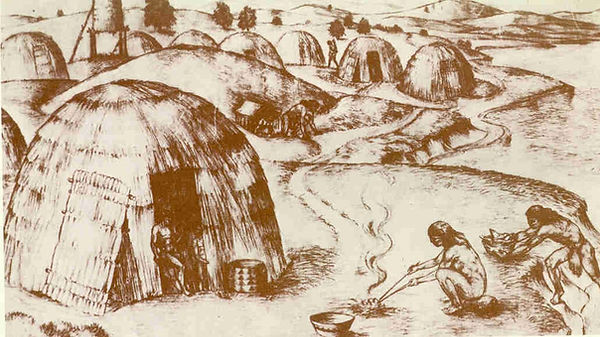
William Gordon Huff, Courtesy of Bella Vista Ranch
THE WINTUN (PATWIN) were the first inhabitants of the Dixon area. Los Californios (Spanish and Mexican Land Grant families) settled in the region in the 19th century and were followed by the Americans from the East Coast and other parts of the world. Patwin means native people in the Wintun language and was given to the native peoples of our area by American reporter and ethnographer Stephen Powers in 1877. The tribal name, however, is Wintun. Powers divided the Wintun, whom he called, Patwin, into three tribes: the Hill Patwin, the River Patwin, and the Southern Patwin. The Wintun, a peaceful tribe, have lived in stewardship with the land for the benefit of humans and the habitat.
LOS WINTUN (PATWIN) fueron los primeros habitantes del área de Dixon. Los Californios (familias españolas y mexicanas de concesiones de tierras) se asentaron en la región en el siglo XIX y después llegaron los estadounidenses de la costa este y de otras partes del mundo. Patwin significa gente indígena en el idioma Wintun. Este nombre se dio a los pueblos indígenas de nuestra zona por el reportero y etnógrafo estadounidense Stephen Powers en 1877. El nombre tribal, sin embargo, es Wintun. Powers dividió a los Wintun (Patwin) en tres tribus: los Patwin del monte, los Patwin del río y los Patwin del sur. Los Wintun, una tribu pacífica, han vivido en administración de la tierra para el beneficio de los humanos y el hábitat.
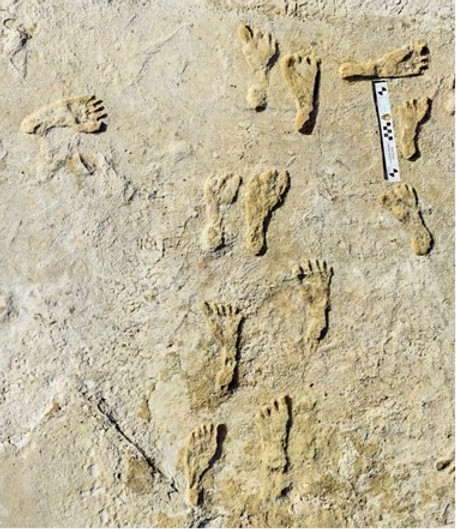
(White Sands National Park, NM - National Park Service, 2006
Fossilized Human Footprints
One theory is that humans migrated 12,000 to 15,000 years ago from Asia and Europe, crossing over a land bridge called Beringia between Asia and North America.
Discovery of human footprints in White Sands National Park, New Mexico, in 2006 pushes this date back to 23,000 years before the land bridge!
Huellas Humanas Fosilizadas
Una teoría dice que los humanos emigraron hace 12,000 a 15,000 años desde Asia y Europa, cruzando un puente terrestre que se llamaba Beringia entre Asia y Norteamérica.
¡El descubrimiento de huellas humanas en el Parque Nacional White Sands, Nuevo México, en el 2006 se remonta a hace 23,000 años antes del Puente terrestre!

Johnson, 1978 – Courtesy of Bella Vista Ranch
Settlements - Asentiamientos
Win: People – Gente
Patwin: Native People in the Wintun language and is not a tribe. Patwin significa Gente Indígena en la lengua wintun y no es una tribu.
Wintun Tribe: Wintun means People Body/Human Being
La Tribu Wintun: Wintun significa Gente Cuerpo/Ser Humano
Dixon Patwin Park/El Parque Patwin de Dixon (See map):
The Wintun (Patwin) territory extended 90 miles from north to south, and 40 miles from east to west, from the lower hills of the eastern North Coast Ranges to the Sacramento River, and from Princeton (Colusa County) south to the San Pablo and Suisun Bays, including the City of Vallejo. This map shows 35 of the 50+ settlements.
El territorio Wintun (Patwin) se extendía 90 millas del norte al sur y 40 millas del este al oeste, desde las colinas más bajas de la cordillera orienta de la costa norte hasta el río Sacramento, y desde Princeton (del Condado de Colusa) al sur hasta las bahías de San Pablo y Suisun, que incluía la ciudad de Vallejo. Este mapa muestra 35 de los más de 50 asentamientos.
Huts and Canoes - Chozas & Canoas

Tule hut exhibit, by C. Peña – Courtesy of Benicia Historical Museum
The Wintun (Patwin) lived in huts, built from willow branches covered in layers of dried tule reeds. Today, the Wintun construct canoes and baskets with the tule reeds grown in the homeland.
Los Wintun (Patwin) vivían en chozas, construidas con ramas de sauce cubiertas con capas de cañas de tule secas. Hoy en día, los Wintun construyen canoas y cestas con las cañas de tule cultivadas en las tierras de la patria.

Tule boat model, by C. Peña - Courtesy of The Bay Model Visitors Center, Sausalito
Acorns, leached of tannic acids and turned into meal and bread, are a staple for the Wintun (Patwin). Groves of oak trees were owned by the tribe. Families gathered the acorns and turned them into mush and bread. They used bedrock and boulder mortars for acorn and other food processing. Small mortar and pestles were personal items and were buried with the individual. In addition to acorns, other foods gathered are sunflower, clover, wild oats, grasses, buckeye, pine nuts, juniper berries, manzanita berries, blackberries, wild grapes, bulbs, and tule roots. Accessibility to these plants becomes more and more challenging for native peoples due to modern methods of land use.

Woman on bedrock, Courtesy of the Bella Vista Ranch
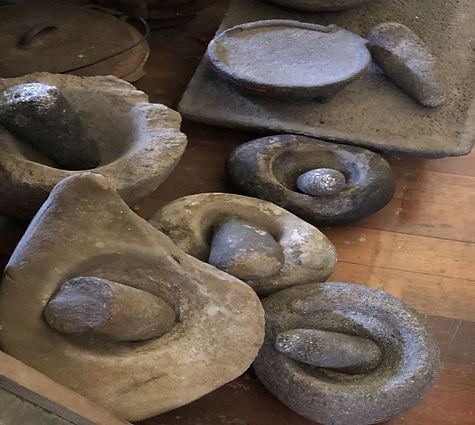
Mortars & Pestles, Courtesy of the Peña Adobe Historical Society
Yield: 6000 lbs./acre
a mature oak tree produces 500-1000 lbs. annually!
Las bellotas, despojadas de ácidos tánicos y convertidas en harina y pan, son un elemento básico para los Wintun (Patwin). Los bosques de robles fueron propiedades de la tribu. Las familias recogían las bellotas y se hacían papilla y pan. Usaron morteros de roca y canto rodado para el procesamiento de las bellotas y otros alimentos. El mortero pequeño y los morteros eran artículos personales que se enterraban con el individuo. Además de las bellotas, otros alimentos recolectados son el girasol, el trébol, la avena silvestre, las gramíneas, el castaño de indias, los piñones, las bayas de enebro, las bayas de manzanita, las moras, las uvas silvestres, los bulbos, y las raíces de tule. La accesibilidad a estas plantas se vuelve cada vez más difícil para los pueblos indígenas debido a los métodos modernos de uso de la tierra.
Baskets - Las Cestas

Courtesy of California State Parks Museum
Baskets were used for carrying, storing, cooking, and serving food. A special type of basket was also used for sifting. Acorn soup was prepared by heating rocks over a fire and then by placing them in a different type of basket to boil the soup. Today, the Wintun make acorn soup by using modern blenders and coffee grinders instead of grinding stones, and the soup is cooked on a stove.
Las cestas se utilizaban para transportar, almacenar, cocinar y servir comidas. También se utilizaba un tipo especial de cesta para tamizar. La sopa de bellota se preparaba calentando piedras al fuego y luego colocándolas en un tipo diferente de cesta para cocinar la sopa. Hoy en día, los Wintun preparan sopa de bellota utilizando licuadoras y molinillos de café modernos en lugar de piedras para moler, y la sopa se cocina en la estufa.
Hunting and Fishing - Cazar Y Pescar
Using bone harpoons and nets made from plant fibers, the Wintun (Patwin) fished for salmon, perch, and suckerfish, and caught waterfowl (duck, quail, and mud hens). Amongst the animals that they hunted were deer, elk and antelope. The Wintun take only what they need. They show respect and acknowledgement to what the plants provide, and to hunted animals for their sacrifices. Every part of the animal is used, nothing is wasted. Some of the bones are used to create games and awls that are used to make baskets, the skin is used to make clothing, antlers are used to make utensils, and other remains are left for other habitats.
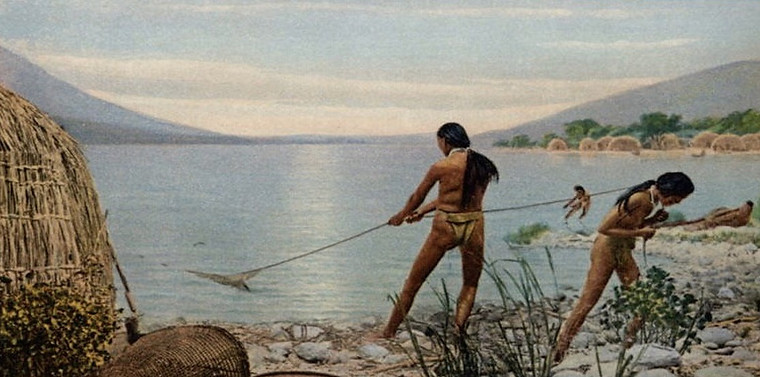
Indians of California – Courtesy of Milwaukee Public Library
Utilizando arpones de hueso y redes hechas de fibras vegetales, los Wintun (Patwin) pescaban salmon, perca y pez lechon, y capturaban aves acuáticas (patos, codornices y gallinas de barro.) Entre los animales que cazaban se encontraban ciervos, alces y antílopes. Los Wintun solo toman lo que necesitan. Muestran respeto y reconocimiento a lo que aportan las plantas y a los animales cazados para sus sacrificios. Se aprovecha cada parte del animal, no se desperdicia nada. Algunos de los huesos se utilizan para crear juegos y los punzones que se utilizan para hacer cestas, la piel se utiliza para hacer ropa, las astas se utilizan para fabricar utensilios y otros restos se dejan para otros hábitats.
Tools, Weapons, and Trade
Herramientas, Armas, Y Comercio
The Wintun traded shells, skins, bows, beads, and obsidian for arrowheads with neighboring tribes.
Los Wintun comerciaban conchas, pieles, arcos, cuentas y obsidiana para las puntas de flecha con las tribus vecinas.
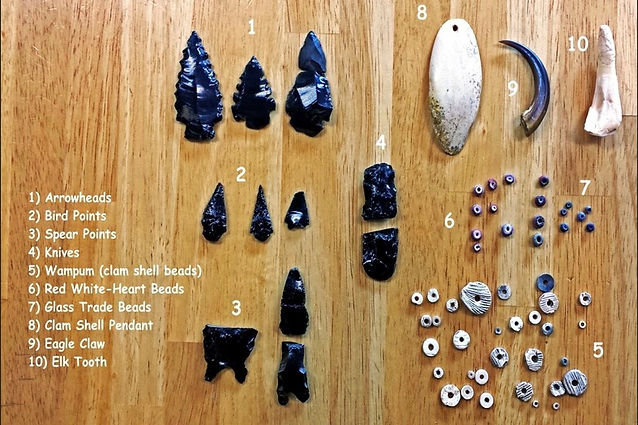
(Picture courtesy of Bella Vista Ranch, Suisun)
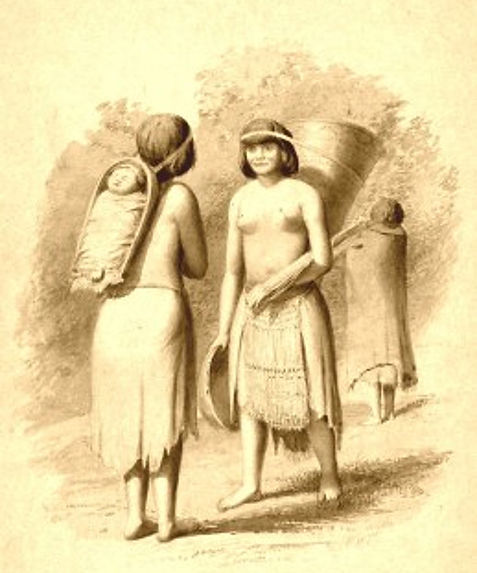
California Indian Women, Upper Sacramento Valley, Drawing by Henry B. Brown, 1851 - 1852 – courtesy of The Huntington Library and Bella Vista Ranch
CLOTHING
The men did not usually wear clothing except in ceremonies. The women who lived near the rivers made skirts from tule reeds or shredded bark. Women in the hills wore skirts made of deer skin. Warm wraps were made of rabbit skins. Hats and shoes were not worn in everyday life.
ROPA
Los hombres no usaban ropa excepto en las ceremonias. Las mujeres que vivían cerca de los ríos hacían faldas hechas de cañas de tule o de cortezas desmenuzadas. Las mujeres de las colinas se ponía faldas hechas de piel de venado. Se hacían mantas cálidas con pieles de conejo. Ni sombreros ni zapatos se usaban en la vida cotidiana.
The Wintun Language - El Idioma Wintun
The Wintun language is just one of approximately 100 native languages once spoken in what is today California. It is made up of three distinct dialects: River Wintun, Hill Wintun, and Southern Wintun. It was the dominant language in what is now Solano County. Various dialects of Wintun (often referred to as Patwin) are spoken across modern day Solano, Yolo, Lake, Napa, and Colusa counties.

El idioma wintun es sólo uno de los aproximadamente 100 idiomas indígenas que se hablaban en lo que hoy es California. Se compone de tres dialectos distintos: el wintun del río, el wintun del monte, y el wintun del sur. El wintun era el idioma dominante en lo que hoy en día es el condado de Solano. Se hablan varios dialectos del wintun (a menudo se refiere como Patwin) en los actuales condados de Solano, Yolo, Lake, Napa, y Colusa.
Sem Yeto (Cheif Solano) (c. 1798-1851)
Starting in San Diego in 1769, Spain established 20 missions across California, as far north as Sonoma, in their drive to convert the native peoples to Christianity and to expand the Spanish empire. The 21st Mission San Francisco Solano was established by Mexico.
Solano County is named for a Wintun (Patwin) leader “Sem Yeto” for whom Spanish Missionaries used the name “Francisco Solano” to identify him. Chief Solano, controversial 19th century leader and diplomat, was an ally to General Vallejo. While we do not know why he became an ally, it is possible that he did this as a leader for the protection of his tribe.

Comenzando en San Diego en el 1769, España estableció 20 misiones en California, hacia el norte hasta llegar a Sonoma en su afán de convertir a los pueblos indígenas al cristianismo y crecer el imperio español. La vigésima primera Misión San Francisco Solano fue establecida por México.
El condado de Solano llevaba el nombre de un líder Wintun (Patwin) “Sem Yeto” a quien los misioneros españoles usaban el nombre “Francisco Solano” para identificarlo. El Jefe Solano, controvertido líder y diplomático del siglo XIX, fue un aliado del General Vallejo. No se sabe el porqué se convirtió en un aliado, pero es possible que como líder lo hiciera para proteger a su tribu.
California Native Peoples
1769 – 1833 – Enslaved at Spanish Missions.
1838 – Enslaved at Sutter’s Fort.
1846 – April 5th massacre of Wintun by Fremont along the Sacramento River.
1848 – California’s Gold Rush brings diseases that killed native peoples.
1848 – 1900 – Wintun population declines to the point of near extinction.
1850 – Governor Burnett – calls for “war of extermination of all Indians.”
1850 – California Act gives Californians the right to own native people as property.
1860 – Bounties increase from 25 cents to $5.00 per Indian scalp.
1851 – 1852 – 18 treaties negotiated with California natives.
1852 – 1905 – 18 treaties hidden by California Government and never ratified.
1862 – Homestead Act gives 160 acres to immigrant families and freed African slaves.
1862 – The Morrill Act – 10 million acres of tribal land was used to build universities.
1924 – Native peoples given the opportunity to finally become U.S. Citizens.
Los Pueblos Indígenas de California
1769 – 1833 - Esclavizados en las misiones españolas.
1838 – Esclavizados en Sutter´s Fort.
1846 – El 5 de abril masacre de Wintun por Fremont a lo largo del Río Sacramento.
1848 – La fiebre del oro de California trae enfermedades que mataron a los indígenas.
1848 – 1900 – La población Wintun disminuye hasta el punto de casi extinción.
1850 – El Gobernador Burnett – pide una “guerra de exterminio de todos los indios.”
1850 – La Ley de California otorga a los californianos el derecho a poseer a los indígenas como propiedad.
1860 – Las recompensas aumentan de 25 centavos a $5.00 dólares por cuero cabelludo indio.
1851 – 1852 – Se negociaron 18 tratados con los indígenas de California.
1851 – 1905 – 18 tratados fueron ocultos por el gobierno de California y nunca se ratificaron.
1862 – La Ley Homestead otorga 160 acres a familias inmigrantes y a esclavos africanos liberados.
1862 – La Ley Morrill – 10 millones de acres de tierras tribales se utilizaron para construir universidades.
1924 – A los pueblos indígenas se les dio la oportunidad de convertirse por fin en ciudadanos estadounidenses.

Library of Congress

Dixon Historical Society Land Acknowledgement
El Reconocimiento de tierras de la Sociedad Histórica Dixon
Three Federally-Recognized Wintun Tribes
Since time immemorial, the land where Dixon and it´s surrounding areas is located has been the home of the Wintun tribal people. Today, there are three federally-recognized Wintun tribes: Cachil Dehe Band of Wintun Indians of the Colusa Indian Community, Kletsel Dehe Band of Wintun Indians (Williams), and Yocha Dehe Wintun Nation (Brooks). Today there are 100+ federally recognized tribal nations in the state of California. They continue to give generously to healthcare systems, food banks, first responders and other organizations.
Tres Tribus Wintun reconocidas a nivel federal
Desde tiempos inmemoriales, la tierra donde se ubica Dixon y sus alrededores ha sido el hogar del pueblo tribal Wintun. Hoy en día, hay tres tribus Wintun reconocidas a nivel federal: La Banda Cachil Dehe de Indios Wintun de la Comunidad India Colusa, la Banda Kletsel Dehe de Indios Wintun (Williams) y la Nación Yocha Dehe Wintun (Brooks). Hoy en día hay más de 100 naciones tribales reconocidas a nivel federal en el estado de California. Continúan contribuyendo generosamente a los sistemas de salud, los bancos de alimentos, los socorristas, y a otras organizaciones.



The Land - La Tierra
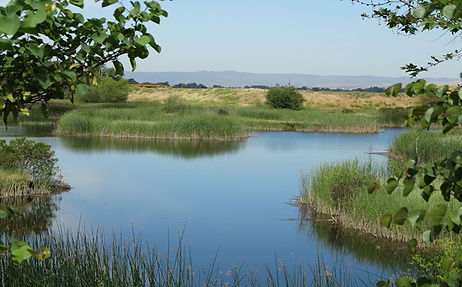
El jardín de cuidado y reunión en la reserva natural de Cache Creek
Estos dos acres ubicados en la tierra natal del pueblo Wintun (Patwin) han sido restaurados con plantas indígenas que se encuentran dentro de la cuenca de Cache Creek. Estas plantas se utilizan para cestería, alimentos, fibras, refugio, medicinas, y embarcaciones.
The Tending and Gathering Garden at the Cache Creek Nature Preserve
These two acres nestled in the homeland of the Wintun (Patwin) people have been restored with native plants found within the Cache Creek watershed. These plants are used for basketry, food, fiber, shelter, medicine, and watercraft.

Today! ¡Hoy en día!
Many educational institutions, churches, and civic organizations acknowledge that the land that we inhabit today is the original land of the native peoples. We can respect and acknowledge those who came before us and support our native friends and neighbors, many of whom are active and contributing members of our communities. The Dixon Historical Society would like to thank The Peña Adobe Historical Society, along with Francisco Quintana, Pam Gonzales, and Kim Schroeder-Evans of Dixon, for their shared knowledge, inclusion of native history, and for their support of native peoples. There are annual events for the public to learn more: The last Friday in September at the Sacramento Capitol is California Indigenous Day, October 12 is Indigenous Peoples Day, and the month of November is Native American History Month.

Courtesy of the Woodland Daily Democrat and the Tending and Gathering Garden of the Cache Creek Nature Preserve.
Wintun practitioner Diana Almendariz shows visitors how to grind and sift acorns.
Diana Almendariz, practicante Wintun, muestra a los visitantes la manera de moler y tamizar bellotas.
Muchas instituciones educativas, iglesias y organizaciones cívicas reconocen que la tierra que habitamos hoy es la tierra original de los pueblos indígenas. Podemos respetar y reconocer a quienes nos precedieron y apoyar a nuestros amigos y vecinos indígenas, muchos de los cuales son miembros activos y contribuyentes de nuestras comunidades. La Sociedad Histórica de Dixon desea agradecer a la Sociedad Histórica de Peña Adobe, y a Francisco Quintana, a Pam Gonzales y a Kim Schroeder-Evans de Dixon, por su conocimiento compartido, la inclusión de la historia indígena, y por apoyar a la gente indígena. Hay eventos anuales donde se puede aprender más: El último viernes de septiembre en el Capitolio de Sacramento es el Día Indígena de California, el 12 de octubre es el Día de los Pueblos Indígenas, y el mes de noviembre es el mes de la Historia de los Americanos Indígenas.

